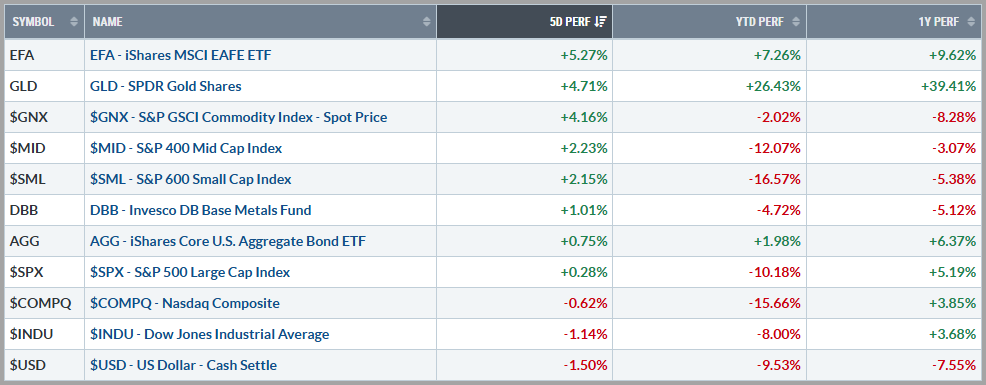Markets Dip as Tariff Tensions Resurface, Bonds Offer a Silver Lining
Markets saw a modest pullback on the holiday shortened session last week, with the S&P 500 declining 1.5% and the Nasdaq slipping around 2.6%. Year-to-date, that puts the S&P 500 down roughly 10.2%, while the Nasdaq has fallen about 15.7%. Much of the recent weakness has been driven by renewed concerns over tariffs. In particular, fresh export restrictions on semiconductors to China weighed heavily on major U.S. chipmakers like NVIDIA. Adding to the cautious mood, Fed Chair Jerome Powell signaled the central bank is likely to remain patient on interest rate cuts, given the dual impact tariffs could have on both inflation and economic growth.
On a brighter note, the bond market offered some relief. As stocks declined, government bond yields fell, leading to gains in bond prices. The yield on the 10-year Treasury dropped by about 0.16% to close the week around 4.3% while the US Dollar closed essentially unchanged, providing a tailwind to commodities in general. Gold rallied another 2.1% to fresh all-time highs, Copper added another 3.5%, and Oil bucked the recent down-trend with a gain of nearly 4%.

Source: stockcharts.com
Tariffs Continue to Take Center Stage
Market sentiment remains closely tied to ongoing developments in the tariff landscape and is seemingly disconnected with the bout of positive economic data that has been released lately. Interestingly, some of the economically sensitive commodities are beginning to “wake up” and the bond market is starting to behave more like it should. If one were to remove the tariff/trade war uncertainties from the equation, the macroeconomic backdrop would actually look very favorable for stocks with the US dollar at cycle lows (this helps large international companies), 10-year treasury yields trading at a reasonable yield, cheap oil, strong employment, the idea of reduced taxation & deregulation, inflation trending downward, positive earnings, and a still growing GDP.
Markets, however, are forward looking vehicles and tend to trade based on the answer to one question- “Are things going to get better or worse?” When uncertainty is entered into the equation, they assume the worst and discount the future until some new catalyst is born. It seems the current catalyst is a negative trade policy, and until we get any certainty, one would assume choppy trade to continue to rule the tape. On the bright side, it appears we know the worst-case scenario regarding the tariff policies, and there are many negotiations taking place over the next couple of months that could ultimately play out very well for our country’s future.
The Week Ahead:
Once again, last week’s hard data was positive with retail sales beating expectations while the survey data (what people expect) was weak.
This week’s economic calendar is relatively quiet, with most of the focus shifting to corporate earnings. Still, the few reports we do get could move markets, especially as investors remain on edge about whether ongoing tariff issues are starting to drag down the economy. The key report to watch is Wednesday’s April flash composite PMI, which offers an early look at how the economy is performing this month. In particular, the service sector PMI will be closely watched since services drive much of U.S. economic growth. If that number shows unexpected weakness, it could raise fresh concerns about a possible recession and put more pressure on stocks.
Thursday brings two more notable reports: Durable Goods Orders and weekly jobless claims. Durable goods give us a glimpse into business spending, but because it covers March, any positive surprise might be dismissed as outdated given current trade tensions. On the flip side, weak data could fuel fears of an economic slowdown. Meanwhile, jobless claims continue to reflect a strong labor market and are one of the few real-time indicators still showing resilience. However, until there’s more clarity on tariffs and trade, even solid labor data may not be enough to ease current investor sentiment.
Tying it all together:
Uncertainty has been driving the markets lately as investors seemingly fear the new administration’s tariff policies and potential trade wars could induce a recession, despite the fact that hard economic data remains largely firm. The S&P 500 technically entered “Bear Market” territory having slid over -20% from its recent highs before rebounding, and the new intermediate trend direction needs to be respected.
So far, defensive sectors, value stocks, and low-volatility names have held up relatively well. At the same time, maintaining diversification and strategically overweighting safe havens like bonds and precious metals has provided added comfort to stay the course. We are certainly not out of the woods just yet, but a glimmer of hope has emerged as some of the economically sensitive assets like commodities have begun to trade up, the dollar has weakened a good bit which may provide a tailwind to corporate profits, and tariff negotiations are underway. Markets are functioning properly with plenty of liquidity and the bond market, aka Smart Money, appears to have calmed down for now.
How this will all play out is yet to be seen but please keep in mind that market downturns, such as the current one, have historically presented opportunities for long-term investors. These periods may allow for acquiring assets at more favorable valuations and securing stronger portfolio yields. It’s important to maintain a long-term perspective while exercising patience, vigilance, and diversification. Historically, these market conditions have tended to be short-lived, often rewarding those who remain focused on their long-term investment goals.
Please feel free to share these commentaries and, should you have any questions regarding your current strategy or the markets in general, please reach out to your CIAS Investment Adviser Representative.
Important Disclosures:
Past performance is not indicative of future results. This material is not financial advice or an offer to sell any product. The statements contained herein are solely based upon the opinions of Edward J. Sabo and the data available at the time of publication of this report, and there is no assurance that any predicted or implied results will actually occur. Information was obtained from third-party sources, which are believed to be reliable, but are not guaranteed as to their accuracy or completeness.
The actual characteristics with respect to any particular client account will vary based on a number of factors including but not limited to: (i) the size of the account; (ii) investment restrictions applicable to the account, if any; and (iii) market exigencies at the time of investment. Capital Investment Advisory Services, LLC (CIAS) reserves the right to modify its current investment strategies and techniques based on changing market dynamics or client needs. The information provided in this report should not be considered a recommendation to purchase or sell any particular security. There is no assurance that any securities discussed herein will remain in an account’s portfolio at the time you receive this report or that securities sold have not been repurchased. The securities discussed may not represent an account’s entire portfolio and in the aggregate may represent only a small percentage of an account’s portfolio holdings. It should not be assumed that any of the securities transactions, holdings or sectors discussed were or will prove to be profitable, or that the investment recommendations or decisions we make in the future will be profitable or will equal the investment performance of the securities discussed herein.
CIAS is a registered investment advisor. More information about the advisor, including its investment strategies and objectives, can be obtained by visiting www.capital-invest.com. A copy of CIAS’s disclosure statement (Part 2 of Form ADV) is available, without charge, upon request. Our Form ADV contains information regarding our Firm’s business practices and the backgrounds of our key personnel. Please contact us at (919) 831-2370 if you would like to receive this information.
Capital Investment Advisory Services, LLC
100 E. Six Forks Road, Ste. 200; Raleigh, North Carolina 27609
Securities offered through Capital Investment Group, Inc. & Capital Investment Brokerage, Inc.
100 East Six Forks Road; Raleigh, North Carolina 27609
Members FINRA and SIPC


